Recently my husband, Bob, and I returned from a trip to Ulaanbaatar, Mongolia on behalf of the Ends of the Earth Ministries of Fort Worth, Texas. We know the director of this Ministry and he asked us to go to Ulaanbaatar to help with maintenance on the Outreach Center there that ‘Ends of the Earth’ supports financially.
The Center is run by Kathy Ribbs, an American, who has done missionary work in Ulaanbaatar, the capital of Mongolia, for the past 30 years. Fifteen years ago Kathy was running a soup kitchen out of a small shack, while also teaching English and spreading the word of God. Seeing the good works that Kathy was doing, and recognizing the need for a bigger facility, Ends of the Earth Ministries built a large 2-story facility on the property. The soup kitchen stayed open until just a few years ago when Kathy, who is now 77 years old, realized she couldn’t keep doing it with the limited help that she had.
Kathy’s ministry now consists of teaching English for free to anyone who wants to learn, feeding those students a mid-day meal along with hungry neighborhood children. Kathy also continues to spread the Gospel as she goes about the neighborhood.
Our main job was to paint the building and do necessary repairs. Two brothers who are painting contractors from Fort Worth joined us. They brought painting supplies including an airless paint sprayer, which made the painting go much faster. Kathy asked me to help her with teaching English, and finding computer programs to help the students learn English. There were a couple of extra bedrooms at the Center, so that is where we stayed for the 11 days that we were there.
Mongolia lies between Russia and China. The average temperature of Ulaanbaatar is 31.3 degrees Fahrenheit, with lows of minus 40 during the winter. When we were there in August, however, it was in the high 70s. The average rainfall is only 10 inches, and they rarely get snow.
Over two times the size of Texas, Mongolia is the most sparsely populated country in the world. The population is about 3 million with approximately half of the people living in Ulaanbaatar. Two out of every five Mongolians live in or close to poverty, and 57% of all poor Mongolians live in gers (yurts), which lack many modern necessities like running water, insulation in their homes, and poor sanitation and heating.
The city of Ulaanbaatar looks like most modern cities where tall skyscrapers dominate the spider web of paved roads. The outskirts of the city, however, contain neighborhoods of small houses, shacks, and gers on rutted dirt lanes. The Outreach Center is in one of those many neighborhoods. Tiny round gers, and the shacks of poor people trying to make it in the city surrounded our large building.
A Mongolian ger (gair) is what people in other parts of the world call a yurt. Nomads traditionally used them because they are collapsible and easy to carry, allowing the nomads to move to give their livestock fresh pastures. There are still many nomads in the steppes and mountains who use them. Since many of the nomads have moved into the city and want to keep their traditional houses, they have brought their gers with them.
A ger is a round felt tent covered with white, waterproof canvas. The wooden frame is like an old-fashioned baby gate made of diamond shapes that are collapsible. Two central columns help support them along with lots of roof poles. There is a hole in the roof to let in light and let heat out. A small metal stove is in the middle to provide heat. In the steppes they burn dried dung or wood. In the city they burn wood or coal. We were told that gers could cost between $5,000 and $17,000.
These poor neighborhoods do not have running water, although most do have electricity. Just outside the Center was a water building where people from the neighborhood, including those of us in the Center, would flock to fill their water containers. Like many other neighborhoods, ours was also hilly, so many people had to trudge up the hill with their containers, sometimes using a two-wheeled cart to hold them.
Almost all these places without running water had metal outhouses in their yards, which must be freezing during the below zero cold of winter. The Center had three outhouses in a side yard. It also had flush toilets, only because inside the house a 50-gallon water barrel was kept full. It was hooked to a pump, so when the toilet was flushed water from the barrel would be used. Flushing was kept to a minimum, however, so the barrel wouldn’t empty so quickly.
There was also a shower there, which used the same barrel and a water heater. Showers were also kept to a minimum because filling the barrel over and over was difficult and tedious. I had taken some shower wipes, like baby wipes but larger, so we used those most of the time.
The Center’s kitchen didn’t have a sink or water barrel. Two large pots with water were kept in the kitchen to use for cooking or for washing dishes.
There is religious freedom in Mongolia. The main religion is Buddhism, which about 50% of the people practice; 40% are non-religious. Christianity makes up only about 2%. Religious groups have to register the group and their place of worship with the government, and children under the age of 16 need written parental permission to participate in religious activities.
We attended three church services while there, one in an apartment house, one in a ger, and the last at the Outreach Center. The last two places may not be registered, but they were well attended.
I had never taught English to non-English speakers before but I have been a teacher all my life, so when Kathy asked me to help her students I dove right in! The students ranged in age from eight to about 30. One of the oldest ones was a physics teacher and another was our driver, Bolero. The students were all polite and eager to learn.
The lessons are free, as is their lunch afterwards. I followed some of the guidelines that Kathy had, but after lots of drills on vocabulary and tenses, I decided a fun break was necessary and started using songs and actions to teach body part words. Even the 14-year-old boy loved doing the “hokey pokey” and singing “head, shoulders, knees, and toes,” with other body parts added as they learned. We’d always finish up with a rousing chorus, “If you’re happy and you know it!”
One day we ventured about 30 miles into the steppe countryside, a beautiful array of different greens broken up by herds of livestock and round, low-slung, white gers. We went to attend the Danshig Naadam festival, which has been symbolizing the solidarity of Mongolia for 100 years!
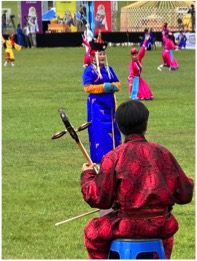
The Danshig Naadam festival, which has been symbolizing the solidarity of Mongolia for 100 years. Provided photo.
A unique festival that preserves Mongolian culture, religious rituals and heritage, most of the participants were Nomads wearing their traditional costumes. Tents, gers, Mongolian and other foods, trinket sales, carnival rides and games were spread all over the hillsides.
The opening ceremony made me think of the Olympic opening ceremony. Hundreds of people took part, all in beautiful costumes. There were dancers and singers of all ages, gymnasts all dressed in gold, young men playing horse head fiddles, bands, men riding horses, each carrying the flag of a different area of Mongolia, and more.
Another day, after the painting of the outside of the building was finished, we celebrated with a trip to the countryside to see the huge stainless steel Genghis Khan Equestrian Statue and the associated museum. The statue is 130-feet tall and sits on top of the 33-foot-tall Museum. We were able to walk up to the head of the horse through its chest and neck. The museum had many artifacts from the 12th-14th centuries.
Although many people associate Genghis Khan with terrible tales of conquest, destruction and bloodshed, the Mongolian people revere him. He established the largest land empire in history, at one time an area about as big as Africa, by creating the world’s most powerful cavalry. He united all the different Mongolian tribes into one, created the first Mongol writing system, and their first postal system. He encouraged religious freedom. He also expanded trade across Asia and Eastern Europe.
We left part of our hearts in Mongolia. The people we met were proud people trying to make it with what they had available to them. Everyone was friendly and went about their business with smiles on their faces. The whole experience was greatly rewarding and we feel that we may have received more from it than those we went to help.
(Bob and Nancy Riggs, Candor residents, recently traveled to Mongolia on a mission trip. Bob, retired from IBM, and Nancy, a retired teacher from Candor Elementary School, recently had the opportunity to work with the Ends of the Earth Ministries of Fort Worth, Texas. They are avid travelers, and love to serve God and their fellow man. The following is Nancy’s brief account of their trip. Nancy has shared a more in-depth account of their experiences on Facebook. You can check it out at: https://www.facebook.com/nancy.riggs.39.)

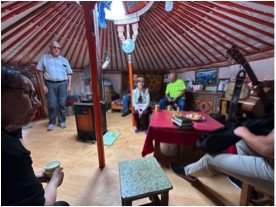


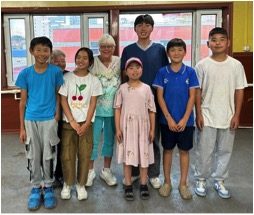
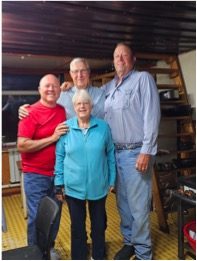
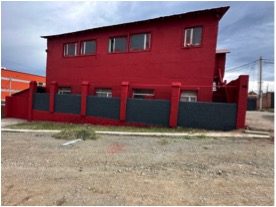
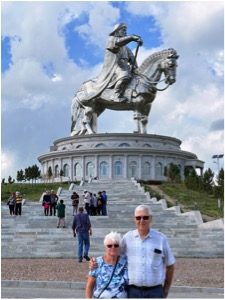

Be the first to comment on "Mission Trip to Mongolia"